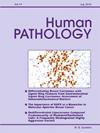TFE3/TFEB altered renal cell carcinomas in end-stage renal disease setting: A single institution clinicopathological study of 4 cases
IF 2.7
2区 医学
Q2 PATHOLOGY
引用次数: 0
Abstract
Introduction
Translocation renal cell carcinoma (tRCC) are morphologically distinct tumors having an underlying disease defining molecular alterations (commonly TFE3/TFEB gene alterations). Their occurrence in the setting of end stage renal disease (ESRD) has been rarely reported. This study was undertaken to assess the occurrence of TFE3/TFEB altered RCCs in ESRD setting at our institution.
Design
By retrospective review, we searched our pathology database for tRCC in ESRD setting over a 14-year period. We analyzed and documented the clinical, histopathological, immunohistochemical, and molecular findings in these tumors.
Results
Out of 223 patients of ESRD associated with RCCs, we found 4 cases of molecularly confirmed TFE3/TFEB-altered RCCs. Three of four patients were on pharmacologic immunosuppression (2 for underlying SLE and 1 for prior liver transplant). The ages ranged from 36 to 74 years (median 48 years) with an equal sex ratio. Tumors were solitary and ranged in size from 1.3 to 4.7 cm (median 2 cm). All four cases were confined to the kidney (pT1) and did not exhibit any necrosis, small vessel invasion, or sarcomatoid/rhabdoid features. The tumors exhibited characteristic morphology (solid, nested and papillary architectures with clear and eosinophilic cytoplasm in TFE3-rearranged RCCs, and biphasic morphology with basement membrane-like material in TFEB-altered RCCs). On immunohistochemistry, tumors consistently expressed cathepsin-K (3/3) & Melan-A (3/3). On molecular studies one case was confirmed via FISH study (TFEB gene rearrangement) and three cases were confirmed via RNA fusionplex (PRCC::TFE3, MED15::TFE3 and MALAT1::TFEB fusion transcripts). The median follow-up was 13 months (range 10–95 months), none of the 4 patients had any local or metastatic recurrences. One patient died of other comorbidities. Background kidney in all 4 patients exhibited variable features of ESRD.
Conclusion
TFE3/TFEB-altered RCCs are rarely encountered in ESRD. Morphological and immunohistochemical findings of tRCC in ESRD replicate those found in sporadic settings. To the best of our knowledge, our study is the first to identify TFEB-rearranged RCCs in an ESRD setting.
终末期肾脏疾病中TFE3/TFEB改变肾细胞癌:4例单机构临床病理研究
易位性肾细胞癌(tRCC)是形态学上不同的肿瘤,具有确定分子改变的潜在疾病(通常是TFE3/TFEB基因改变)。它们在终末期肾脏疾病(ESRD)中发生的报道很少。本研究旨在评估我院ESRD患者TFE3/TFEB改变rcc的发生率。设计:通过回顾性分析,我们在病理数据库中检索了ESRD患者在14年间发生的tRCC。我们分析并记录了这些肿瘤的临床、组织病理学、免疫组织化学和分子发现。结果在223例与rcc相关的ESRD患者中,我们发现了4例分子证实的TFE3/ tfeb改变的rcc。4例患者中有3例接受药理学免疫抑制(2例为潜在SLE, 1例为既往肝移植)。年龄从36岁到74岁不等(中位48岁),男女比例相等。肿瘤单发,大小1.3 ~ 4.7 cm(中位2 cm)。所有4例均局限于肾脏(pT1),未表现出任何坏死、小血管侵犯或肉瘤样/横纹肌样特征。肿瘤表现出特征性形态(tfe3重排的rcc呈实心、巢状和乳头状结构,胞浆清晰且嗜酸性,tfe3改变的rcc呈双相形态,呈基底膜样物质)。在免疫组织化学上,肿瘤一致表达cathepsin-K (3/3) &;Melan-A(3/3)。在分子研究中,通过FISH研究(TFEB基因重排)证实了1例,通过RNA融合(PRCC::TFE3, MED15::TFE3和MALAT1::TFEB融合转录物)证实了3例。中位随访时间为13个月(10-95个月),4例患者均无局部或转移性复发。1例患者死于其他合并症。背景:4例患者肾脏均表现出不同的ESRD特征。结论tfe3 / tfeb改变的rcc在ESRD中少见。ESRD中tRCC的形态学和免疫组织化学发现重复了零星情况下的发现。据我们所知,我们的研究是第一个在ESRD环境中识别tfeb重排rcc的研究。
本文章由计算机程序翻译,如有差异,请以英文原文为准。
求助全文
约1分钟内获得全文
求助全文
来源期刊

Human pathology
医学-病理学
CiteScore
5.30
自引率
6.10%
发文量
206
审稿时长
21 days
期刊介绍:
Human Pathology is designed to bring information of clinicopathologic significance to human disease to the laboratory and clinical physician. It presents information drawn from morphologic and clinical laboratory studies with direct relevance to the understanding of human diseases. Papers published concern morphologic and clinicopathologic observations, reviews of diseases, analyses of problems in pathology, significant collections of case material and advances in concepts or techniques of value in the analysis and diagnosis of disease. Theoretical and experimental pathology and molecular biology pertinent to human disease are included. This critical journal is well illustrated with exceptional reproductions of photomicrographs and microscopic anatomy.
 求助内容:
求助内容: 应助结果提醒方式:
应助结果提醒方式:


